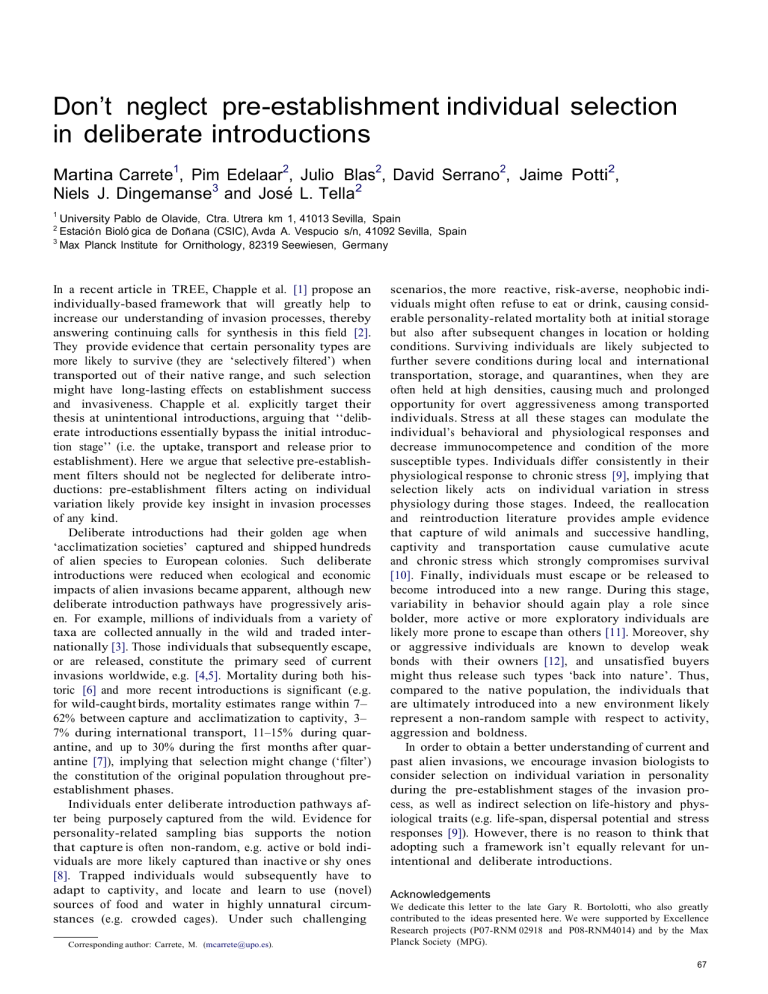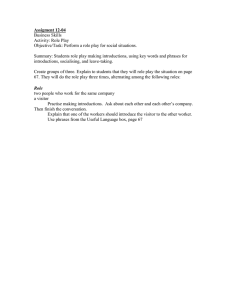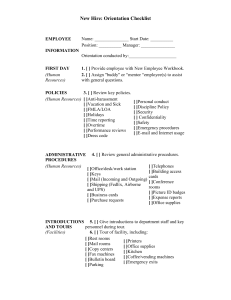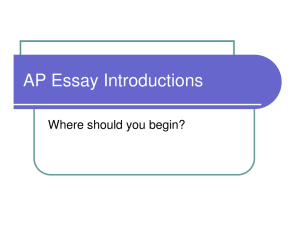TREE.doc

Don’t neglect pre-establishment individual selection in deliberate introductions
Martina Carrete
1
, Pim Edelaar
Niels J. Dingemanse
3
2
, Julio Blas and Jose´ L. Tella
2
2
, David Serrano
2
, Jaime Potti
2
,
1 University Pablo de Olavide, Ctra. Utrera km 1, 41013 Sevilla, Spain
2 ´ n Biolo´ gica de Don˜ ana (CSIC), Avda A. Vespucio s/n, 41092 Sevilla, Spain
3
Max Planck Institute for Ornithology, 82319 Seewiesen, Germany
In a recent article in TREE, Chapple et al. [1] propose an individually-based framework that will greatly help to increase our understanding of invasion processes, thereby answering continuing calls for synthesis in this field [2] .
They provide evidence that certain personality types are more likely to survive (they are ‘selectively filtered’) when transported out of their native range, and such selection might have long-lasting effects on establishment success and invasiveness. Chapple et al. explicitly target their thesis at unintentional introductions, arguing that ‘‘delib- erate introductions essentially bypass the initial introduc- tion stage’’ (i.e. the uptake, transport and release prior to establishment). Here we argue that selective pre-establish- ment filters should not be neglected for deliberate intro- ductions: pre-establishment filters acting on individual variation likely provide key insight in invasion processes of any kind.
Deliberate introductions had their golden age when
‘acclimatization societies’ captured and shipped hundreds of alien species to European colonies. Such deliberate introductions were reduced when ecological and economic impacts of alien invasions became apparent, although new deliberate introduction pathways have progressively aris- en. For example, millions of individuals from a variety of taxa are collected annually in the wild and traded inter- nationally [3] . Those individuals that subsequently escape, or are released, constitute the primary seed of current invasions worldwide, e.g. [4,5] . Mortality during both his- toric [6] and more recent introductions is significant (e.g. for wild-caught birds, mortality estimates range within 7–
62% between capture and acclimatization to captivity, 3–
7% during international transport, 11–15% during quar- antine, and up to 30% during the first months after quar- antine [7] ), implying that selection might change (‘filter’) the constitution of the original population throughout pre- establishment phases.
Individuals enter deliberate introduction pathways af- ter being purposely captured from the wild. Evidence for personality-related sampling bias supports the notion that capture is often non-random, e.g. active or bold indi- viduals are more likely captured than inactive or shy ones
[8] . Trapped individuals would subsequently have to adapt to captivity, and locate and learn to use (novel) sources of food and water in highly unnatural circum- stances (e.g. crowded cages). Under such challenging scenarios, the more reactive, risk-averse, neophobic indi- viduals might often refuse to eat or drink, causing consid- erable personality-related mortality both at initial storage but also after subsequent changes in location or holding conditions. Surviving individuals are likely subjected to further severe conditions during local and international transportation, storage, and quarantines, when they are often held at high densities, causing much and prolonged opportunity for overt aggressiveness among transported individuals. Stress at all these stages can modulate the individual’s behavioral and physiological responses and decrease immunocompetence and condition of the more susceptible types. Individuals differ consistently in their physiological response to chronic stress [9] , implying that selection likely acts on individual variation in stress physiology during those stages. Indeed, the reallocation and reintroduction literature provides ample evidence that capture of wild animals and successive handling, captivity and transportation cause cumulative acute and chronic stress which strongly compromises survival
[10] . Finally, individuals must escape or be released to become introduced into a new range. During this stage, variability in behavior should again play a role since bolder, more active or more exploratory individuals are likely more prone to escape than others [11] . Moreover, shy or aggressive individuals are known to develop weak bonds with their owners [12] , and unsatisfied buyers might thus release such types ‘back into nature’. Thus, compared to the native population, the individuals that are ultimately introduced into a new environment likely represent a non-random sample with respect to activity, aggression and boldness.
In order to obtain a better understanding of current and past alien invasions, we encourage invasion biologists to consider selection on individual variation in personality during the pre-establishment stages of the invasion pro- cess, as well as indirect selection on life-history and phys- iological traits (e.g. life-span, dispersal potential and stress responses [9] ). However, there is no reason to think that adopting such a framework isn’t equally relevant for un- intentional and deliberate introductions.
Acknowledgements
We dedicate this letter to the late Gary R. Bortolotti, who also greatly contributed to the ideas presented here. We were supported by Excellence
Research projects (P07-RNM 02918 and P08-RNM4014) and by the Max
Planck Society (MPG).
Corresponding author: Carrete, M. ( mcarrete@upo.es
).
67
References
1 Chapple, D.G. et al. (2012) Can behavioural and personality traits influence the success of unintentional species introductions? Trends
Ecol. Evol. 27, 57–64
2 Blackburn, T.M. et al. (2011) A proposed unified framework for biological invasions. Trends Ecol. Evol. 26, 333–339
3 Carrete, M. and Tella, J.L. (2008) Non-native wildlife risk assessment: a call for scientific inquiry- Response. Front Ecol.
Environ. 6, 466–467
4 Carrete, M. and Tella, J.L. (2008) Wild-bird trade and exotic invasions: a new link of conservation concern? Front. Ecol. Environ.
6, 207–211
5 Romagosa, C.M. et al. (2009) Contribution of the live-vertebrate trade toward taxonomic homogenization. Conserv. Biol. 23, 1001–
1007
6 Moulton, M.P. et al. (2012) A reassessment of historical records of avian introductions to Australia: no case for propagule pressure. Biodiv.
Conserv. 21, 155–174
7 Thomsen, J.B. et al. (1992) Perceptions, conservation and management of wild birds in trade, TRAFFIC International, WWF and IUCN,
(Cambridge)
8 Biro, P.A. and Dingemanse, N.J. (2009) Sampling bias resulting from animal personality. Trends Ecol. Evol. 24, 66–67
9 Carere, C. et al. (2010) Covariation between personalities and individual differences in coping with stress: converging evidence and hypotheses. Curr. Zool. 56, 728–740
10 Teixeira, C.P. et al. (2007) Revisiting translocation and reintroduction programmes: the importance of considering stress. Anim. Behav. 73, 1–13
11 Minderman, J. et al. (2009) Personality traits in wild starlings: exploration behavior and environmental sensitivity. Behav. Ecol. 20,
830–837
12 Wedl, M. et al. (2010) Relational factors affecting dog social attraction to human partners. Interact. Stud. 11, 482–503
0169-5347/$
– see front matter
© 2011 Elsevier Ltd. All rights reserved. doi: 10.1016/j.tree.2011.11.011 Trends in Ecology and Evolution, February 2012, Vol. 27, No. 2
Intraspecific behavioral variation is important in both deliberate and unintentional species introductions: response to Carrete et al.
David G. Chapple, Sarah M. Simmonds and Bob B.M. Wong
School of Biological Sciences, Monash University, Clayton, VIC 3800, Australia
In a recent review in TREE [1] , we outlined a conceptual framework for how inter-and intraspecific behavioral vari- ation may influence the success of unintentional species introductions, particularly during the pre-establishment phase of the introduction process [2] . Carrete and collea- gues [3] argue that selective factors acting on intraspecific behavioral variation can also be important in the success of deliberate species introductions prior to establishment. We agree. Indeed, our review included several examples of how behavioral variability could enhance the post-establish- ment success of deliberately introduced species [4] .
However, Carrete et al. imply that we did not consider individual-level behavioral variation to be important dur- ing the pre-establishment phase of deliberate species intro- ductions. This is incorrect and appears to stem from a misinterpretation of several statements in our review relating to intentional species introductions bypassing the initial stages of the introduction process. We were simply highlighting, as have others [5–7] , that the selection of species for intentional introduction is heavily influenced by human biases for species with particular traits or attributes (e.g. for biocontrol or the pet trade). That is, our statement related to the biased selection of species rather than to intraspecific behavioral variation.
Nonetheless, in the context of deliberate introductions,
Carrete et al. outline several behaviors that may predispose certain individuals to capture, survival during transport and captivity, and release from captivity. Given that our review largely focused on unintentional species introduc- tions, the behaviors highlighted by Carrete et al. provide an informative and valuable discussion that not only reinforces one of our key points, that pre-establishment factors are important determinants of invasion success, but also broad- ens the application of our conceptual framework to both deliberate and unintentional species introductions.
Although pre-establishment factors may be important in the success of both types of species introduction, we argue that the selective pathways differ between deliberate and unintentional introductions. For deliberately introduced species, humans select the species that are introduced into new regions and, within these, selection acts on intraspecific behavioral variation (and variation in other traits) during capture, captivity, transport and release [3] . By contrast, unintentional introductions may be more reliant on biologi- cal factors, because interspecific trait and behavioral varia- tion influences both the ‘opportunity’ and propensity of a species for transportation [1] . As outlined in our review, once ensnared in the transport vector, intraspecific behavioral variation may contribute to the likelihood of transitioning through the initial stages of the introduction process. How- ever, despite these different pathways, important similari- ties in behaviors or personalities (e.g. boldness, exploratory behavior or aggression) could influence the success of both unintentional [1] and deliberate [3] introductions during the pre-establishment phase.
Acknowledgments
We were supported by funding from the Australian Research Council (to
DGC, DP0771913), Hermon Slade Foundation (HSF09/02), and the
National Geographic Society (8085-06 and 8952-11).
References
1 Chapple, D.G. et al. (2012) Can behavioral and personality traits influence the success of unintentional species introductions? Trends
Ecol. Evol. 27, 57–64
Corresponding author: Chapple, D.G. ( David.Chapple@monash.edu
).
68



